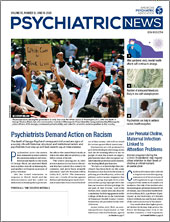In the years following World War II, Americans were exposed to just how deprived their public psychiatric hospitals were of even a modicum of decency, much less the capability to provide treatment to patients. Muckraking journalism, such as Albert Deutch’s book Shame of the States (1948) and Albert Maisel’s article in Life Magazine, “Bedlam” (1946), as well as a first-person account written as a novel, Mary Jane Ward’s Snake Pit (1946), grabbed readers’ attention.
Over the subsequent 75 years, the more scurrilous the portrayal of the psychiatric hospital—both public and private—the greater its audience. Noteworthy are the book and then film versions of One Flew Over the Cuckoo’s Nest and Girl Interrupted. Perhaps it should come as no surprise that the COVID-19 pandemic would bring out new portrayals of psychiatric inpatient settings failing miserably to keep patients safe and provide adequate treatment. Today’s version of Dr. Kik, like his predecessor in the Snake Pit, fights for his patients against villainous administrators who fail to see past their own foolishness and greed to their tasks of meeting patients’ needs.
Is this a fair representation of American psychiatric inpatient services during the COVID-19 pandemic? Or does this sensationalism fall under the penumbra of what U.N. Secretary-General António Guterres has called a “pandemic of misinformation.”
A case in point is Masha Gessen’s article in the April 21
New Yorker, “Why Psychiatric Wards Are Uniquely Vulnerable to the Coronavirus.” There surely are characteristics of psychiatric patients and inpatient settings that pose unique challenges to efforts to contain the contagion of COVID-19. These have been covered previously in
Psychiatric News. Gessen, in contrast, presents a drama of the crusading psychiatrist—usually the medical director—fighting the penurious administrators in a futile, Don Quixote–like struggle.
Gessen wrote that she spoke to psychiatrists working on inpatient units in for-profit, nonprofit, and state hospitals, and they uniformly reported they were lacking testing, personal protective equipment (PPE), and seclusion protocols while having conflicts with hospital administrators. She named a few hospitals, including Western State Hospital in Washington, which had at least 27 staff and six patients who had tested positive for COVID-19 and one death in mid-April. She warned these numbers were low because testing was extremely limited. She mentioned Greystone Park Psychiatric Hospital in New Jersey, where 33 patients (10% of the inpatients) and 42 employees had tested positive, and four patients had died. She described one hospital that had revised patients’ schedules to achieve social distancing, but this left patients with long hours with nothing to do except stay in nearly empty bedrooms where patients have no televisions, telephones, cell phones, tablets, or computers; some MP3 players were provided by the hospital, but there were not enough for every patient. A large state hospital with one staff death and nine patient deaths had to send patients to a nearby general hospital for testing. She was critical that some psychiatrists were improvising ways to deal with COVID-19 as they went along, as if they had other choices.
After reading the article, I wondered whether it was really this bad everywhere. On a couple of psychiatry listservs that I’m on, I mentioned the New Yorker article and asked if anyone had a different story. These are the responses I received the first day:
In a New England state, a university hospital unit had 14 of its 20 psychiatric beds filled but had no COVID-19 cases. The one state hospital had 165 of 180 beds filled and no COVID-19 patients, but the state hospital did have a COVID-19 unit set up and ready to go. PPE was no issue at the university hospital; it had been a major issue at the state hospital early on, but that was not the case by mid-April. In a Pennsylvania hospital with 64 of its 89 psychiatric beds filled, the hospital had converted rooms with two beds for adults into single rooms and one- and two-bed rooms for children. The hospital had no COVID-19 positive cases and no difficulties with PPE supplies. In Wisconsin, a 60-bed psychiatric hospital had three to five COVID-19 cases at any given time with no deaths. The hospital had all the PPE it needed. In the Central Plains states, there were two psychiatric hospitals of 200 and 250 beds and one 16-bed psychiatric unit that provided data, and none had had a COVID-19 positive case. At one of these hospitals, staff had procured their own masks and gowns. In California, at one hospital with psychiatric units’ census totaling 48 beds, there had been no COVID-19 cases and no problems obtaining PPE.
After barraging the reader with calamitous examples of failures in dealing with COVID-19, Gessen made some important points: (1) it is not a good idea for general hospital psychiatric units to push patients into state hospitals, causing them in turn to move patients to transitional facilities, which then prematurely discharge individuals to residential settings where they are at risk for coronavirus infection; (2) sending patients into communities at a “terrifying time” should be done with more caution than under more typical circumstances; and (3) running hospitals as if they are businesses sets up doctors to battle against hospital bureaucracies where the only potential winners are “the ones looking at this from a long-term financial-sustainability standpoint.” These points would have been better made had Gessen described a more balanced, nuanced backdrop.
Massachusetts, where I work, did not make the mistakes Gessen highlighted. A case in point: I have been spending about 40 to 45 hours a week at Worcester Recovery Center and Hospital (WRCH) throughout the pandemic. In mid-April there were 245 patients at WRCH (capacity 290) when all patients were tested for COVID-19. The results were a positive rate of less than 2%. That same week, the 114 residents at the Worcester Homeless Shelter were tested, and the positive rate there was 43%. During the first two weeks of May, all WRCH employees not previously tested were tested, and 1.5% were positive for COVID-19. Including all employees tested since March 30, the positive rate was 2.7% of about 1,100 employees tested. By the end of May, 16 of the 30 staff who had tested positive were back at work. There were no COVID-19–related deaths among patients or staff. These results were obtained by employing all manner of emergency protocols and procedures (see
Psychiatric News, for details).
Unlike the hospitals about which Gessen wrote, when WRCH patients spend time alone in their single bedrooms, they may have—and almost every patient has some of these—a cell phone, iPad, iPod, laptop, MP3 player, wireless headphones, television set, and other electronics. The Rehabilitation Department has continued to provide ongoing services and modify the parameters week to week depending on CDC, state public health, and other recommendations. Clinical meetings were a mix of staff in the room and staff joining by remote access such that the staff in the room could stay six or more feet apart. All staff and patients must wear masks. There are “huddles” that include administrators and clinicians, just administrators, and just members of single disciplines going on all day. These meetings are almost entirely remote.
Fundamental to achieving a safe environment for patients and staff at WRCH has been both a high degree of shared sense of purpose and very frequent and effective communication between hospital administration and clinical staff, as well as strong support from the commissioner of mental health and her staff and the secretary of Health and Human Services and her staff.
Due mainly to discomfort that gets twisted into prejudice and discrimination, psychiatric inpatient settings have long been the subject of parody, hyperbole, derision, and vilification. In his 1958 APA presidential speech, Harry Solomon remarked, “The large mental hospital is antiquated, outmoded, and rapidly becoming obsolete. … I do not see how any reasonably objective view of our mental hospitals today can fail to conclude they are bankrupt beyond remedy.” Just over a century earlier, U.S. President Franklin Pierce, in perhaps the most poetic description of a state hospital ever, portrayed state hospitals as, “munificent establishments of local beneficence.” There is no psychiatric hospital today that is either of these. And, no doubt, each patient’s experience in a psychiatric hospital is unique.
There’s no good time to disparage psychiatric hospitals as a class, but the middle of the COVID-19 pandemic is a particularly bad time to do so. It is extremely irresponsible to discourage people who need inpatient psychiatric care to not get it. Some people won’t go, and they will die because they didn’t. ■

